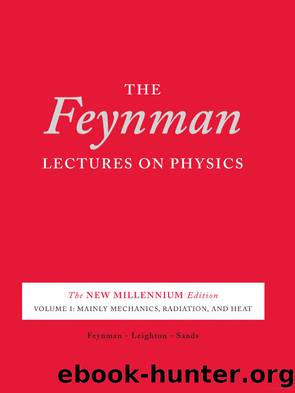The Feynman Lectures on Physics, Volume I by unknow

Author:unknow
Language: eng
Format: epub
Published: 2014-05-19T16:00:00+00:00
Fig. 30â3. A linear array of equal oscillators, driven with phases .
Now let us consider further how we may apply Eq. (30.3) in different circumstances, and try to understand what is happening. Let us consider our sources to be all on a line, as drawn in Fig. 30â3. There are of them, all spaced by a distance , and we shall suppose that the intrinsic relative phase, one to the next, is . Then if we are observing in a given direction from the normal, there is an additional phase because of the time delay between each successive two, which we talked about before. Thus
First, we shall take the case . That is, all oscillators are in phase, and we want to know what the intensity is as a function of the angle . In order to find out, we merely have to put into formula (30.3) and see what happens. In the first place, there is a maximum when . That means that when all the oscillators are in phase there is a strong intensity in the direction . On the other hand, an interesting question is, where is the first minimum? That occurs when . In other words, when , we get the first minimum of the curve. If we get rid of the âs so we can look at it a little better, it says that Now let us understand physically why we get a minimum at that position. is the total length of the array. Referring to Fig. 30â3, we see that . What (30.5) says is that when is equal to one wavelength, we get a minimum. Now why do we get a minimum when ? Because the contributions of the various oscillators are then uniformly distributed in phase from to . The arrows (Fig. 30â1) are going around a whole circleâwe are adding equal vectors in all directions, and such a sum is zero. So when we have an angle such that , we get a minimum. That is the first minimum.
There is another important feature about formula (30.3), which is that if the angle is increased by any multiple of , it makes no difference to the formula. So we will get other strong maxima at , , , and so forth. Near each of these great maxima the pattern of Fig. 30â2 is repeated. We may ask ourselves, what is the geometrical circumstance that leads to these other great maxima? The condition is that , where is any integer. That is, . Dividing by , we see that This looks like the other formula, (30.5). No, that formula was . The difference is that here we have to look at the individual sources, and when we say , that means that we have an angle such that . In other words, each source is now contributing a certain amount, and successive ones are out of phase by a whole multiple of , and therefore are contributing in phase, because out of phase by is the same as being in phase.
Download
This site does not store any files on its server. We only index and link to content provided by other sites. Please contact the content providers to delete copyright contents if any and email us, we'll remove relevant links or contents immediately.
The Complete Stick Figure Physics Tutorials by Allen Sarah(7291)
Secrets of Antigravity Propulsion: Tesla, UFOs, and Classified Aerospace Technology by Ph.D. Paul A. Laviolette(5299)
Thing Explainer by Randall Munroe(3864)
The River of Consciousness by Oliver Sacks(3519)
The Order of Time by Carlo Rovelli(3131)
How To by Randall Munroe(3016)
A Brief History of Time by Stephen Hawking(2947)
I Live in the Future & Here's How It Works by Nick Bilton(2922)
The Great Unknown by Marcus du Sautoy(2632)
What If?: Serious Scientific Answers to Absurd Hypothetical Questions by Randall Munroe(2626)
Midnight in Chernobyl by Adam Higginbotham(2473)
Blockchain: Ultimate Step By Step Guide To Understanding Blockchain Technology, Bitcoin Creation, and the future of Money (Novice to Expert) by Keizer Söze(2430)
Networks: An Introduction by Newman Mark(2341)
The Meaning of it All by Richard Feynman(2288)
Easy Electronics by Charles Platt(2271)
The Tao of Physics by Fritjof Capra(2221)
Midnight in Chernobyl: The Untold Story of the World's Greatest Nuclear Disaster by Adam Higginbotham(2166)
When by Daniel H Pink(2075)
Introducing Relativity by Bruce Bassett(2064)
